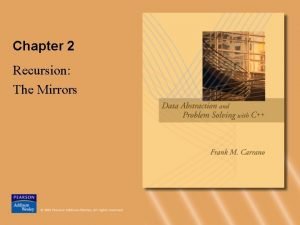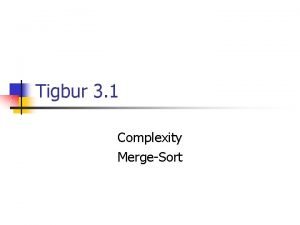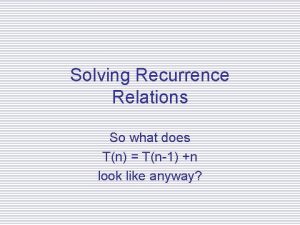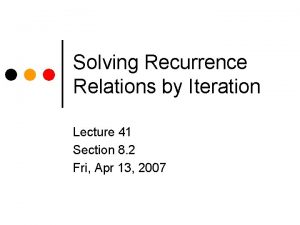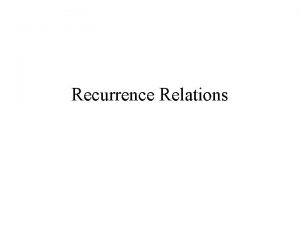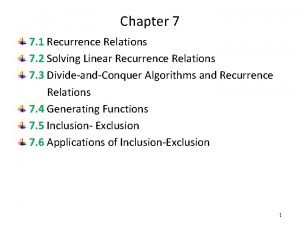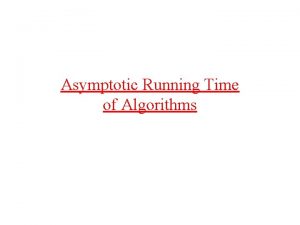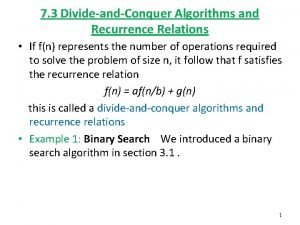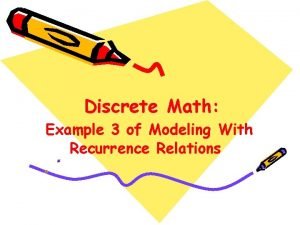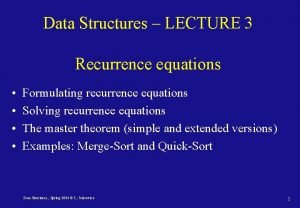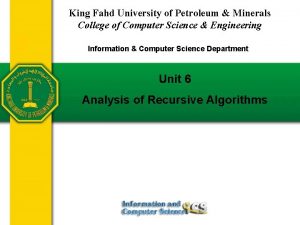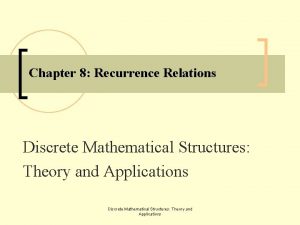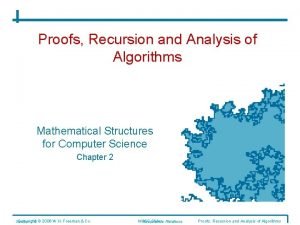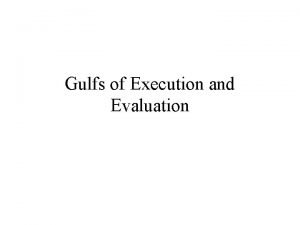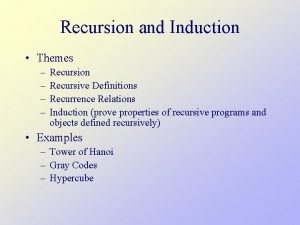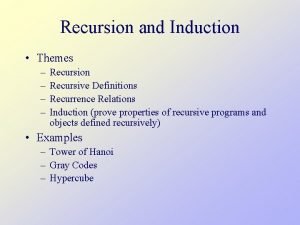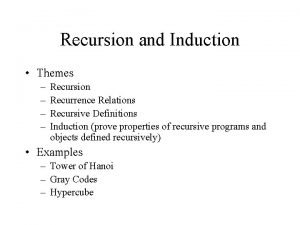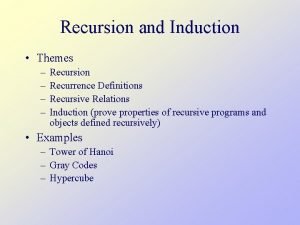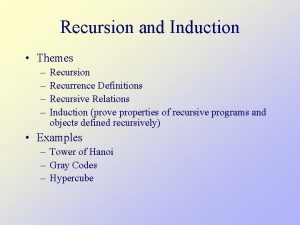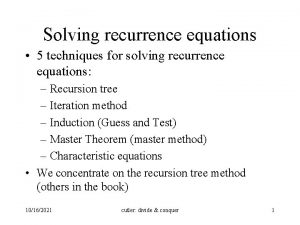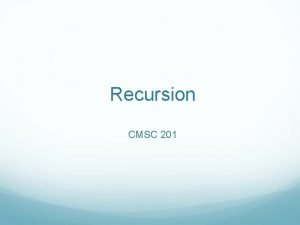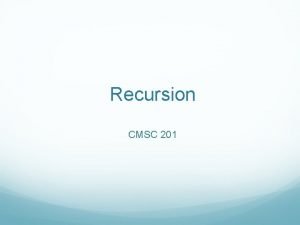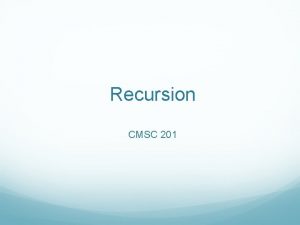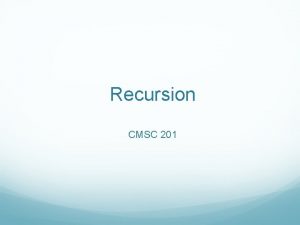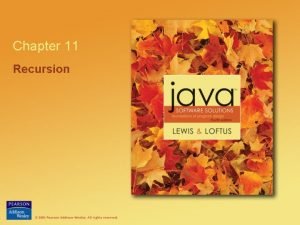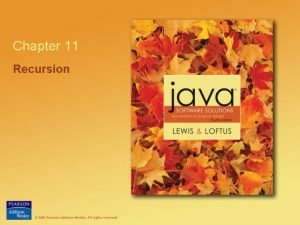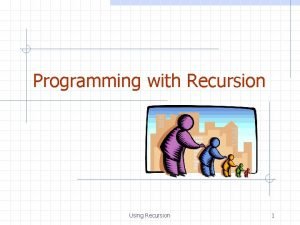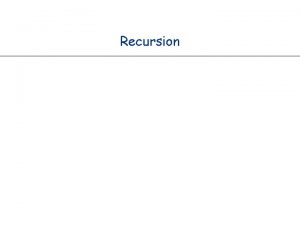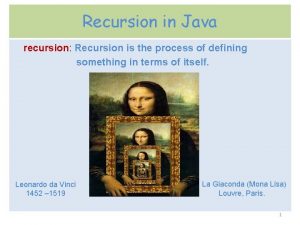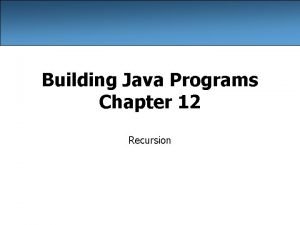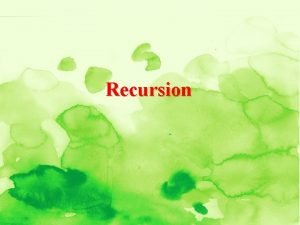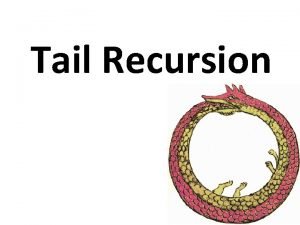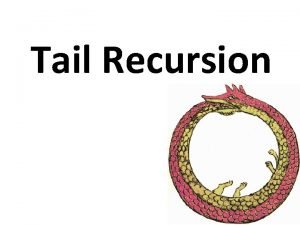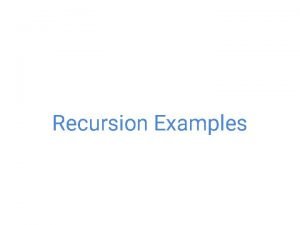Recursion and Recurrence Equations The execution of a




![AR=Activation Record ep= environmental pointer free memory AR(fact 1) N =1 function value [=1] AR=Activation Record ep= environmental pointer free memory AR(fact 1) N =1 function value [=1]](https://slidetodoc.com/presentation_image_h/fed4b34ec1bf42efccd4235c65ac56fc/image-5.jpg)
![free memory N =3 function value [=6] AR(fact 3) return address static link = free memory N =3 function value [=6] AR(fact 3) return address static link =](https://slidetodoc.com/presentation_image_h/fed4b34ec1bf42efccd4235c65ac56fc/image-6.jpg)



















- Slides: 25

Recursion and Recurrence Equations • The execution of a recursive program • Deriving recurrence equations Cutler/Head

Recursion • What is the recursive definition of n! ? • Translating to Java/c int fact(int n) { if (n<=1) return 1; // Note '*' is done after returning from fact(n-1) else return n*fact(n-1); } 12/8/2020 Cutler/Head 2

Recursive algorithms • A recursive algorithm typically contains recursive calls to the same algorithm • In order for the recursive algorithm to terminate, it must contain code for solving directly some “base case(s)” • A direct solution does not include recursive calls. • We use the following notation: • Direct. Solution. Size is the “size” of the base case • Direct. Solution. Count is the count of the number of operations done by the “direct solution” 12/8/2020 Cutler/Head 3

A Call Tree for fact(3) The Run Time Environment • The following 2 slides show the program stack after the third call from fact(3) • When a function is called an activation records('ar') is created and pushed on the program stack. • The activation record stores copies of local variables, pointers to other ‘ar’ in the stack and the return address. • When a function returns the stack is popped. returns 6 fact(3) 6 * 3 fact(2) 2 fact(1) * 2 1 1 int fact(int n) { if (n<=1) return 1; else return n*fact(n-1); } 12/8/2020 Cutler/Head 4
![ARActivation Record ep environmental pointer free memory ARfact 1 N 1 function value 1 AR=Activation Record ep= environmental pointer free memory AR(fact 1) N =1 function value [=1]](https://slidetodoc.com/presentation_image_h/fed4b34ec1bf42efccd4235c65ac56fc/image-5.jpg)
AR=Activation Record ep= environmental pointer free memory AR(fact 1) N =1 function value [=1] return address static link = ep 0 dynamic link = EP free memory EP AR(fact 2) AR(fact 3) AR(Driver) N =2 function value [=? ] return address static link = ep 0 dynamic link =ep 2 N =3 function value [=? ] return address static link = ep 0 dynamic link =ep 1 AR(fact 2) N =2 function value [=2] return address static link = ep 0 dynamic link = EP ep 2 AR(fact 3) N =3 function value [=? ] return address static link = ep 0 dynamic link = ep 1 Val fact: <ip. F, ep 0> AR(Driver) ep 1 Val fact: <ip. F, ep 0> ep 0 Program stack Snapshot of the environment at end of third call to fact 12/8/2020 EP Snapshot of the environment at end of second call to fact Cutler/Head 5
![free memory N 3 function value 6 ARfact 3 return address static link free memory N =3 function value [=6] AR(fact 3) return address static link =](https://slidetodoc.com/presentation_image_h/fed4b34ec1bf42efccd4235c65ac56fc/image-6.jpg)
free memory N =3 function value [=6] AR(fact 3) return address static link = ep 0 dynamic link = EP AR(Driver) EP free memory Val AR(Driver) fact: <ip. F, ep 0> ep 0 Program stack EP Program stack Snapshot of the environment at end of first call to fact after fact l returns 12/8/2020 Cutler/Head 6

Goal: Analyzing recursive algorithms • Until now we have only analyzed (derived a count) for non-recursive algorithms. • In order to analyze recursive algorithms we must learn to: • Derive the recurrence equation from the code • Solve recurrence equations. 12/8/2020 Cutler/Head 7

Deriving a Recurrence Equation for a Recursive Algorithm • Our goal is to compute the count (Time) T(n) as a function of n, where n is the size of the problem • We will first write a recurrence equation for T(n) For example T(n)=T(n-1)+1 and T(1)=0 • Then we will solve the recurrence equation When we solve the recurrence equation above we will find that T(n)=n, and any such recursive algorithm is linear in n. Solving: Next lecture 12/8/2020 Cutler/Head 8

Deriving a Recurrence Equation for a Recursive Algorithm 1. Determine the “size of the problem”. The count T is a function of this size 2. Determine Direct. Sol. Size, such that for size Direct. Sol. Size the algorithm computes a direct solution, and the Direct. Sol. Count(s). 12/8/2020 Cutler/Head 9

Deriving a Recurrence Equation for a Recursive Algorithm To determine General. Count: 3. Identify all the recursive calls done by a single call of the algorithm and their counts, T(n 1), …, T(nk) and compute Recursive. Call. Sum = 4. Determine the “non recursive count” t(size) done by a single call of the algorithm, i. e. , the amount of work, excluding the recursive calls done by the algorithm 12/8/2020 Cutler/Head 10

Deriving Direct. Solution. Count for Factorial int fact(int n) { if (n<=1) return 1; // Note '*' is done after returning from fact(n-1) else return n*fact(n-1); 1. Size = n 2. Direct. Sol. Size is (n<=1) 3. Direct. Sol. Count is (1) The algorithm does a small constant number of operations (comparing n to 1, and returning) 12/8/2020 Cutler/Head 11

Deriving a General. Count for Factorial int fact(int n) { if (n<=1) return 1; // Note '*' is done after returning from fact(n-1) Operations else counted in return n * fact(n-1); The only recursive t(n) call, requiring T(n - 1) operations 3. Recursive. Call. Sum = T( n - 1) 4. t(n) = (1) 12/8/2020 (for if, *, -, return) Cutler/Head 12

Deriving a Recurrence Equation for Mystery In this example we are not concerned with what mystery computes. Our goal is to simply write the recurrence equation mystery (n) 1. if n 1 2. then return n 3. else return (5 * mystery(n -1) 6* mystery(n -2) ) 12/8/2020 Cutler/Head 13

Deriving a Direct. Solution. Count for Mystery 1. Size = n Direct. Sol. Size is (n<=1) 3. Direct. Sol. Count is (1) The algorithm does a small constant number of operations (comparing n to 1, and returning) 2. 12/8/2020 Cutler/Head 14

Deriving a General. Count for Mystery mystery (n) 1. if n 1 2. then return n 3. else A recursive call to Mystery requiring T(n - 1) A recursive call to Mystery requiring T(n - 2) return (5 * mystery(n -1) 6 * mystery(n - 2) ) Operations counted in t(n) 12/8/2020 Cutler/Head 15

Deriving a Recurrence Equation for Mystery 3. Recursive. Call. Sum = T(n-1) + T(n-2) 4. t (n)= (1) The non recursive count includes the comparison n<=1, the 2 multiplications, the subtraction, and the return. So (1). 12/8/2020 Cutler/Head 16

Deriving a Recurrence Equation for Multiply(y, z)//binary multiplication 1. if (z ==0) return 0 2. else if z is odd 3. then return (multiply(2 y, z/2 ) + 4. else return (multiply(2 y, z/2 )) Barometer operation y) To derive the recurrence equation we need to determine the size of the problem. The variable which is decreased and provides the direct solution is z. So we can use z as the size. Another possibility is to use n which is the number of bits in z (n= lg z +1). Let addition be our barometer operation. We do 0 additions for the direct solution. So Direct. Solution. Size =0, and Direct. Solution. Count=0 12/8/2020 Cutler/Head 17

Deriving a Recurrence Equation for Multiply 1. Recursive. Call. Sum = T(z/2) t(z) = 1 addition in the worst case. So Solving this equation we get T(z)= (lg z)= (n). 2. Recursive. Call. Sum = T(n-1) since z/2 has n-1 bits Solving this equation we get T(n)= (n) 12/8/2020 Cutler/Head 18

Deriving a recurrence equation for minimum Minimum(A, lt, rt) // minimum(A, 1, length(A)) 1. if rt - lt 1 2. then return (min(A[lt], A[rt])) 3. else m 1 = minimum(A, lt, (lt+rt)/2 ) 4. m 2 = minimum(A, (lt+rt)/2 +1, rt) 5. return (min (m 1, m 2)) • This procedure computes the minimum of the left half of the array, the right half of the array, and the minimum of the two. • Size = rt-lt+1= n • Direct. Solution. Size is n = (rt - lt)+1 1+1=2. • Direct. Solution. Count = (1) 12/8/2020 Cutler/Head 19

Deriving a recurrence equation for minimum Minimum(A, lt, rt) // minimum(A, 1, length(A)) 1. if rt - lt 1 2. then return (min(A[lt], A[rt])) 3. else m 1 = minimum(A, lt, (lt+rt)/2 ) 4. 5. m 2 = minimum(A, (lt+rt)/2 +1, rt) return (min (m 1, m 2)) Two recursive calls with n/2 elements. So T(n/2) + T(n/2) 12/8/2020 Cutler/Head 20

Deriving a recurrence equation for Merge Sort: 1 if (n 2) 2 move. First( S, S 1, (n+1)/2)) // divide 3 move. Second( S, S 2, n/2) // divide 4 Sort(S 1) // recurs 5 Sort(S 2) // recurs 6 Merge( S 1, S 2, S ) // conquers Direct. Solution. Size is n<2 Direct. Solution. Count is (1) Recursive. Call. Sum is T( n/2 ) + T( n/2 ) The non recursive count t(n) = (n) 12/8/2020 Cutler/Head 21

Recurrence Equation for cost. • The implementation of the moves costs Q(n) and the merge costs Q(n). So the total cost for dividing and merging is Q(n). • The recurrence relation for the run time of Sort is T(n) = T( n/2 ) + Q(n). T(0) =T(1) = Q(1) • The solution is T(n)= Q(nlg n) 12/8/2020 Cutler/Head 22

Computing xn • We can decrease the number of times that x is multiplied by itself by observing that to compute x 8 we need only 3 multiplications (x 2=x*x, x 4=x 2*x 2, and x 8=x 4*x 4) and when we want of compute x 9, we need 4 multiplications (x 2=x*x, x 4=x 2*x 2, x 8=x 4*x 4 and x 9= x 8*x) • A recursive procedure for computing xn should be (lg n) • For the following algorithm we will derive the worst case recurrence equation. • Note: we are ignoring the fact that the numbers will quickly become too large to store in a long integer 12/8/2020 Cutler/Head 23

Recursion - Power long power (long x, long n) { if (n == 0) { return 1; } else { long p = power(x, n/2); if ((n % 2) == 0) { return p*p; } else { return x * p*p; } } } We use the * as our barometer operation. 12/8/2020 Cutler/Head 24

Deriving a Recurrence Equation for Power Size = n Direct. Solution. Size is n=0; Direct. Solution. Count is 0; Recursive. Call. Sum is T(n/2) // t(n) = 2 multiplications in the worst case T(n)=0 for n=0 T(n)=T(n/2)+2 for n>0 12/8/2020 Cutler/Head 25
 To understand recursion you must understand recursion
To understand recursion you must understand recursion Common recurrence relations
Common recurrence relations Rabbits and recurrence relations
Rabbits and recurrence relations Selection sort recurrence relation
Selection sort recurrence relation Recurrence rate
Recurrence rate Recurrence relation for linear search
Recurrence relation for linear search Solve for a
Solve for a Linear homogeneous recurrence relation examples
Linear homogeneous recurrence relation examples Recurrence relation
Recurrence relation Recurrence relation computer science
Recurrence relation computer science Hsv-1 genital recurrence rate
Hsv-1 genital recurrence rate Recurrence relation
Recurrence relation Asymptotic cheat sheet
Asymptotic cheat sheet Algorithm recurrence relation
Algorithm recurrence relation Unrolling the recurrence
Unrolling the recurrence Recurrence relation
Recurrence relation Recurrence discrete math
Recurrence discrete math Recurrence data structures
Recurrence data structures Recurrence relation of recursive selection sort
Recurrence relation of recursive selection sort Recurrence relation in discrete mathematics
Recurrence relation in discrete mathematics What is recurrence equation
What is recurrence equation Advanced counting techniques
Advanced counting techniques 9-3 polar and rectangular forms of equations
9-3 polar and rectangular forms of equations Translate word equations to chemical equations
Translate word equations to chemical equations Direct and manage project execution
Direct and manage project execution Gulf of execution and evaluation examples
Gulf of execution and evaluation examples


